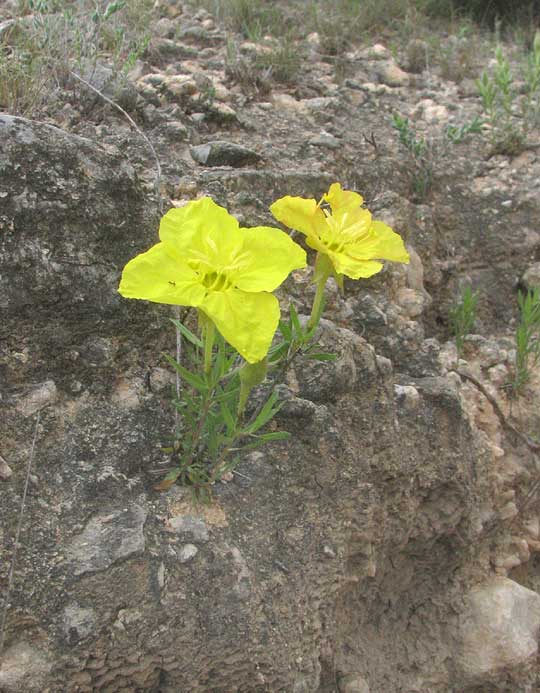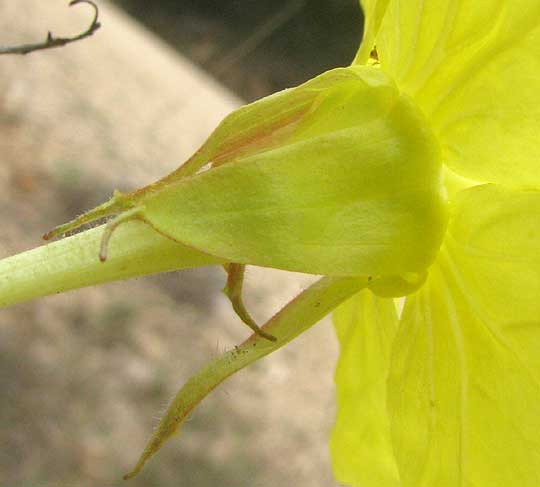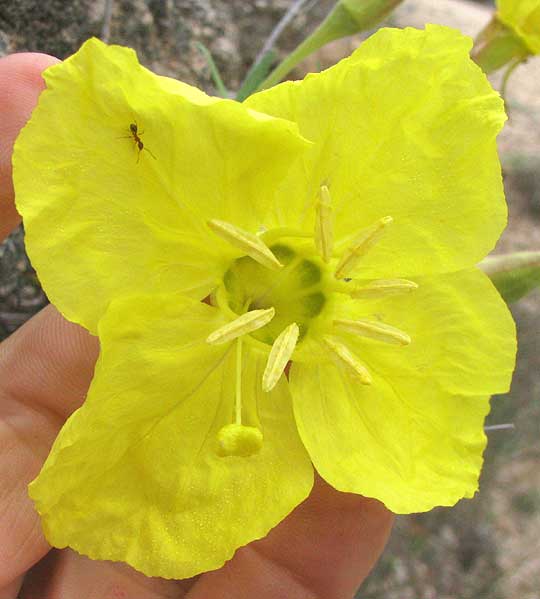Excerpts from Jim Conrad's
Naturalist Newsletter
from the April 21, 2013 Newsletter issued from the Frio Canyon Nature Education Center in northern Uvalde County, southwestern Texas, on the southern border of the Edwards Plateau; elevation ~1750m (~5750 ft); N29.62°, W99.86°; USA
WESTERN PRIMROSE FLOWERING
Sprouting from a roadcut were several ten-inch tall (25cm), branching stems atop which floated three-inch wide (8cm) blossoms so yellow on that dark, overcast morning that the flowers seemed to glow from an inner light. Below a picture barely hints at the effect they produced:

Notice that the blossoms bear four petals, not the more typical number of five for such flower types, so that's a good field mark. The way the sizable sepals bend backwards and end with such slender tips also is a field mark, shown below:

When you see such large, yellow, four-petaled blossoms with reflexed sepals of this manner, you should think "the Primrose Family, the Onagraceae. In fact, when I saw these plants I assumed they were primroses themselves, genus Oenothera. Oenothera is one of my favorite genera because back in the 70s when I worked at the Missouri Botanical Garden in St. Louis I was sent to South America for two months to collect seeds from Oenothera species. Today I cannot see an Oenothera without remembering the broad, blue sky above the Argentine Pampas, wind screaming among jagged, wildflower-rich pinnacles of the Bolivian Andes, Paraguay's hot, dry Chaco region...
About 125 Oenothera species are recognized, and some display very limited distribution areas -- they're narrowly endemic -- so I hoped for a rare find here. However, it turns out that these spectacular little beings occur fairly regularly in prairies, meadows, pastures and savannahs in arid northern Mexico and across the border in Arizona and as far north as southern Colorado and Kansas, including most of western Texas.
They're about equally known as Western Primroses and Hartweg's Sundrops. Even their technical name is in dispute, some specialists calling it OENOTHERA HARTWEGII and others placing it in a completely different genus, naming it CALYLOPHUS HARTWEGII. My former boss at the Missouri Botanical Gardens, Peter Raven, is the one who removed this plant from Oenothera and assigned it in Calylophus, though I would most happily see it retained in its traditional genus, Oenothera.
One reason Dr. Raven banished our pretty plant from the evening primrose genus is that the stigmas of its blossoms don't look right for Oenothera. You can see the X-shaped stigma terminating a slender style drooping from the throat of a Pink Evening Primrose, Oenothera speciosa, which we saw in southernmost Texas last year, at http://www.backyardnature.net/n/12/120401of.jpg.
In Oenotheras, stigmas are supposed to be X-shaped. Now look at the stigma similarly ending the drooping style of one of our roadcut blossoms, shown below:

Our roadcut flower's stigma is not X-shaped at all, but rather more spherical, and only slightly four-lobed.
Well, in the world of plant taxonomy, little differences like that mean a lot. Over a hundred evening primrose species produce X-shaped stigmas, and then along comes our plant whose stigma is a slightly four-lobed sphere, so what do you do?